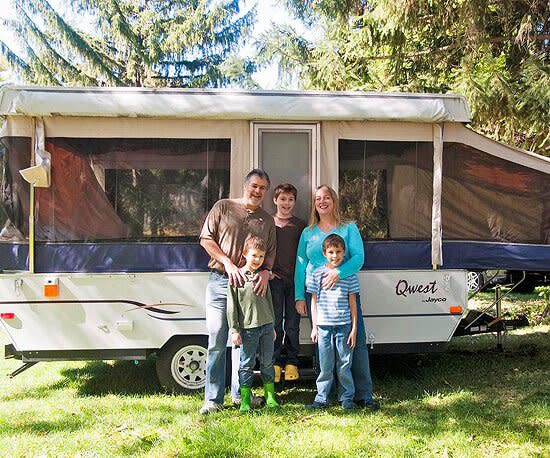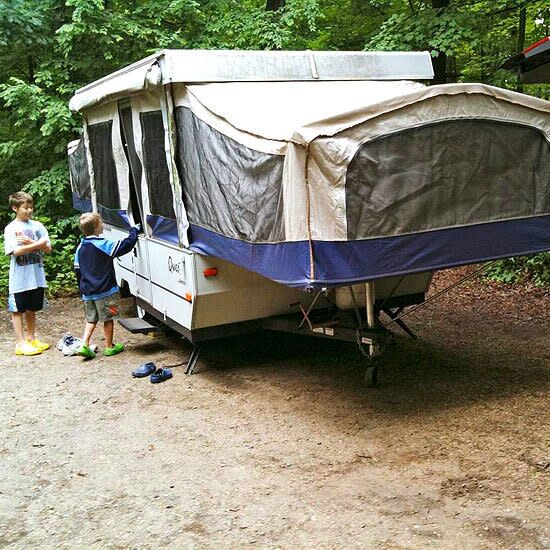Our Tent on Wheels: A Pop-Up Camper Vacation

Toni McLellan
We are a family of campers. My husband, Daniel, and I, along with our kids (Jackson, age 13, Nolan, 9, and Aaron, 8), have always loved packing our gear and heading off to explore some national park or wilderness area. But camping for us these days means two tents and plenty of setup. And while we sturdy outdoorsy types aren't supposed to admit it, sleeping on the ground has begun to feel less adventurous and more uncomfortable. So when a friend offered to sell us his pop-up camper at an affordable price, we were curious. After we saw the unit in action -- and watched it transform from a compact, road-ready trailer to a room equipped with comfy beds, two tables, electricity, and running water -- we were eager to take it for a test drive. Here's what we discovered on our first overnight trip, to Mirror Lake State Park near the Wisconsin Dells.
When it comes to manageability, a pop-up unit falls somewhere between a motor home, which requires hardly any setup in camp, and a tent, which requires quite a bit. Unlike RVs, most pop-ups don't have bathrooms or showers, but they do provide other luxuries. Their slide-out beds, for example, make sleeping far more comfortable than in a tent, and odds are you'll have more living space than you would even in one of those behemoth "condo" tents. Once you've towed a pop-up to camp and unhitched it, your car is free for trips to local attractions -- a much easier option than negotiating your way through towns in an RV.
Our pop-up was 8 years old but well cared for, and it fit both our budget ($1,500) and our family of five. Before buying one, consider renting or find a campground that offers pop-ups as a lodging option (as state and national parks sometimes do). RV dealerships and outdoors shows can give you a firsthand look at the various models, features, and pricing. New pop-up campers range in price from about $5,000 to $22,000.
When it was time to hit the road, we already had two essentials: a vehicle large enough to tow the pop-up, and a trailer hitch (if you don't have one, the cost of installation starts at around $150). We practiced hitching and unhitching the camper a few times at home to get the hang of it. Then came the real challenge: driving with the trailer hooked behind us. As it turned out, it didn't feel that much different from driving without the camper, though it took us a few minutes to adjust to the camper's occasional bobble and sway. We just stayed in the right lane and kept to the speed limit.

Toni McLellan
Popping In -- and Up
After we arrived at Mirror Lake, we stopped at the visitors' center to pick up our permit and get free activity books for the boys. Then came the most intimidating part of the trip: backing into the campsite between the electric and water hookups. Some campgrounds offer what are called pull-through sites, but ours wasn't one of them. After a few tries, we nailed it, and we were home for the weekend. When we unhitched the car, our youngest son, Aaron, turned the crank to raise the pop-up, while his brothers helped slide out and stabilize the beds on either end. Then all three rushed inside to unzip the plastic window covers, set up the tables, and play on the beds.
After years of lugging camping dishes to an outdoor faucet, having a sink and counter space felt like a luxury, but the water pressure wasn't great, so we ended up rinsing our dishes at the outdoor faucet anyway. (Some campgrounds have better water pressure than others.) Daniel and I didn't think to bring our coffeemaker and grinder, an oversight we won't repeat. But the propane stove that we could use inside or out was handy, and thanks to the mini fridge, we ate healthier meals and snacks on the cheap.
Although we had clear skies on our trip, being in a shelter with windows that can be closed gave us peace of mind. On cooler nights, the built-in heater (powered by electricity or propane) was a welcome amenity, as were the outlets that allowed us to run a portable fan in hot weather and to charge our phones. Our favorite time in the camper was when we were just hanging out, gathered around the two tables. We read, played board games, and worked on our nature activity books while sipping coffee and cocoa. The kids loved reading by flashlight behind their beds' privacy curtains, and we all loved waking to birdsong and the scent of pines. As our weekend wound down, we were already planning our next adventure.
Toni McLellan, the founder of Makearoo.com, lives with her family in Woodstock, Illinois.
Originally published in the June/July 2012 issue of FamilyFun magazine.
